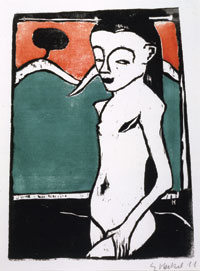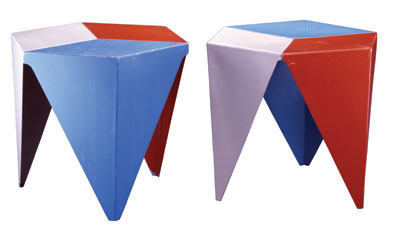Defiance Despair Desire
20th-Century German Expressionists
Revive the Art of Printmaking
By Lorrie Flom
“One
feels the pulse of an artist when one contemplates
his graphic work.…The needle, the crayon, the
cutting knife are simpler and therefore more penetrating
means of expression than brush and color.” These
words from German artist Gustave Schiefler capture
the essence of the German Expressionist movement—an
attempt by artists during the early decades of the
20th century to communicate the depths of human experience,
primarily through printmaking.
 This
woodcut depicts a 12-year-old girl named Fränzi
(Lina Franziska Fehrmann), one of many children
who frequented the Brücke communal studio.
Heckel and the other Brücke artists preferred
Fränzi’s awkward yet natural positions
to the artificial stances of professional models. This
woodcut depicts a 12-year-old girl named Fränzi
(Lina Franziska Fehrmann), one of many children
who frequented the Brücke communal studio.
Heckel and the other Brücke artists preferred
Fränzi’s awkward yet natural positions
to the artificial stances of professional models.
Erich Heckel, German, Stehendes
Kind (Standing Child), 1910/11, color woodcut, Marcia
and Granvil Specks Collection
German Expressionism
is one of the major printmaking movements of
the 20th century, according to Linda Batis,
Carnegie Museum of Art’s associate curator
of fine arts. “Although some of these artists
worked as painters and sculptors as well, they all
considered
printmaking to be critical to their work,” says
Batis. Drawing on a 400-year-old tradition of German
printmaking, German Expressionist artists “spontaneously
reinvented the medium,” she explains. Visitors
will be able to experience the power and raw beauty
of German Expressionist prints when the
exhibition
Defiance Despair Desire: German Expressionist Prints
from the Marcia and Granvil Specks Collection opens
at Carnegie Museum of Art on June 12. This exhibition,
organized by the Milwaukee Art Museum, presents
prints by 32 artists, including such luminaries
of the German
Expressionist movement as Käthe Kollwitz,
Max Beckmann, George Grosz, Max Pechstein, and
Emil Nolde.
 Conrad
Felixmüller, an artist and political activist
from Dresden, founded the publication Menschen (People)
to discuss the plight of European workers following
the war. In the 1920s he depicted the life of workers
in the industrial Ruhr River Valley, but often he used
his
own family as subject matter. Conrad
Felixmüller, an artist and political activist
from Dresden, founded the publication Menschen (People)
to discuss the plight of European workers following
the war. In the 1920s he depicted the life of workers
in the industrial Ruhr River Valley, but often he used
his
own family as subject matter.
Conrad Felixmüller,
German, Selbstbildnis mit Frau (Self-Portrait with
Wife), 1920/1921, Milwaukee
Art Museum
Concerned
with such universal issues as war, death,
inequality and injustice, the alienation of
city life, and man’s relationship with nature,
these artists were inspired by the bold, primitive,
and expressive
styles of Paul Gauguin, Edvard Munch, and Vincent
van Gogh. “If you look at the woodcuts
of German Expressionist artists, they’re
unrefined yet beautiful,” says Batis. “These
artists weren’t especially concerned with
developing highly skilled technique. They were
more concerned
with expressing themselves as spontaneously as
possible.” In
fact, many of these artists were untrained in
the medium, yet carved, printed, and distributed
their
woodcuts
themselves, seeking to communicate with the broadest
audiences possible. Along with reviving the woodcut
as an expressive medium, German Expressionist
artists also utilized such time-honored printmaking
techniques
as etchings, aquatints, drypoints, and lithographs. The
works in Defiance Despair Desire capture a
period of tremendous social unrest in pre-
and
post-World
War I Germany. Batis says, “This is a beautiful
show that surveys the subject very thoroughly.” Among
Batis’ favorite works in the exhibition
are the color woodcuts by Erich Heckel that she
describes as, “very
bold, simplified, and extremely powerful,” and
the works of Emil Nolde, which she calls “wonderful
prints, very experimental. He was a real craftsman.”
Museum visitors also will have an opportunity
to explore the earliest roots of German printmaking
in a companion
show featuring 65 prints from 15th-and 16th-century
Germany that are part of Carnegie Museum of
Art’s
permanent collection. “I think it will be fascinating
for visitors to see how printmaking started out 400
years earlier,” says Batis. The 20th-century
German Expressionist prints are “fresh and different…astonishing
really,” she adds. “It’s almost as
if they went back to the 15th-century craft and said, ‘let’s
reinvent it.’”
UPDATE:

The Best Minds in the Business Help Shape the
2004 Carnegie International
Since its earliest years, the Carnegie International
has drawn on the expertise of an international advisory
committee to select artists and artworks. Laura Hoptman,
curator of the 2004 Carnegie International, says that
the committee’s contributions are invaluable: “One
individual can’t know what is going on throughout
the world. Advisors are our eyes and ears.”
Typically,
the committee members are chosen by the curator.
Laura has known each of her committee members
over the past decade through her curatorial work
at The Museum of Modern Art (MoMA) in New York City
and
elsewhere. Her international “dream team” includes:
Francesco Bonami, curator of contemporary art at
the Museum of Contemporary Art in Chicago and curator
of
the 2003 Venice Biennale; Gary Garrels, chief curator
of drawing at MoMA; Japanese art critic Midori Matsui;
Cuauhtemoc Medina, a professor of art criticism and
a curator in Mexico; and artist Rirkrit Tiravanija,
a professor at Columbia University whose work appeared
in the 1995 Carnegie International.
The committee
members offer different perceptions of international
art and provide important feedback
during
the three years of preparation for the exhibition.
Besides meeting three or four times to view slides
and discuss artists and works, committee members
keep in close contact by email, sharing images
and ideas.
For this International, each committee member also
contributed articles about different artists for
the exhibition’s catalogue.
Although the
Carnegie International has a single curator,
Laura says it could not succeed without
this international
committee working in concert. “It’s
extraordinary to get so much expertise together
for one exhibition,” she
says. “The International is curated by one
individual, but not without the help of some of
the best minds
in the business.”
More Aluminum by Design
A New Exhibition Highlights Recent Acquisitions
April 17 - August 8,
2004 • Forum Gallery

Isamu Noguchi, designer
American, Pair of Alcoa Forecast Program Tables, 1957,
aluminum,
gift of Torrence M. Hunt Sr.
Aluminum
may be the most abundant metal on earth, but it wasn’t
until the
last 100 years or so that aluminum’s versatility,
light weight, and beauty were widely explored by
manufacturers and designers. That period
of discovery led to many of the greatest design and
construction advances of the 20th century, a fact
that was not lost on Carnegie Museum of Art, which
began to seriously collect designed objects made
from aluminum in 1997, in the process
of organizing the exhibition, Aluminum by Design:
Jewelry to Jets.
Since its closing in Pittsburgh
in 2001, the exhibition has traveled to such cities
as Paris, Montreal, London,
Brussels, New York, and Miami. As a result of the
tour’s success, the Museum of Art is recognized
as one of the leading collectors of aluminum design,
and it remains committed to enhancing its collection
of aluminum objects.
More Aluminum by Design, on
view in the Forum Gallery through August 8, features
some of the more significant
and fascinating aluminum design objects that
have been acquired by the museum, either by gift
or
purchase, since the 2000 exhibition opened. “Aluminum
is an amazing material that designers have reveled
in exploring and exploiting,” says Sarah
Nichols, curator of decorative arts. “This
attraction is captured by the varied, fascinating,
and important
objects in the museum’s collection.”
A
pair of tables designed by Isamu Noguchi in
1957 for Alcoa and a credenza designed by The
German
Fire Proofing Company in 1958 for Reynolds
Metals are
among the objects that Nichols says are outstanding
examples of the aluminum industry’s promotion
of the metal’s use in designed objects.
Another piece from the 1950s is a two-piece dress
made of
aluminum thread and rhinestones. And for
a more contemporary twist, there is a screen
made in 1993 by Brazilian brothers Fernando
and Humberto
Campana from recycled television antennas.
Recent Aquisition:
Allegory of Life by Giorgio Ghisi

Giorgio Ghisi, Italian, Allegory
of Life (The Dream of Raphael), 1561, engraving,
Charles J. Rosenbloom and Leisser Art Fund
Giorgio Ghisi is considered one of the most important
mid-16th-century Italian engravers. When Curator
Linda Batis found an outstanding impression of Ghisi’s
most important print, Allegory of Life, she jumped
at the opportunity to acquire it for Carnegie Museum
of Art. “These major prints are becoming impossible
to find,” says Batis. “They’re
rare on the market. So, when a museum has an opportunity
to acquire one, it is an opportunity not to be missed.”
Allegory of Life is a large, complex work that has
never been fully deciphered. For more than 400 years,
commentators have struggled with the interpretation
of this work. Despite their differing views, they
all agree the message is a hopeful one.
Batis said
this particular print fits in well with Carnegie
Museum of Art’s permanent collection.
The museum has very important examples of Italian
printmaking, including Andrea Mantegna (late 15th
century) and Giulio Campagnola (early 16th century),
says Batis. “One of the things I’ve tried
to do is to create a historical continuum of printmaking
in the museum’s collection. By adding certain
landmarks, such as this Ghisi print, it’s possible
to survey the medium,” she explains. “In
addition, this print really is gorgeous.”
Back to Contents |